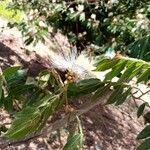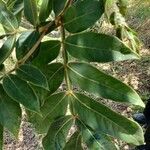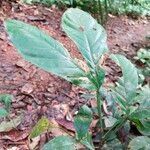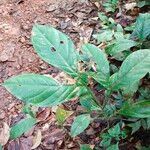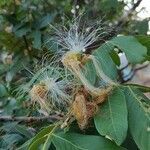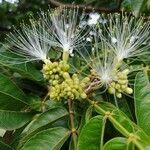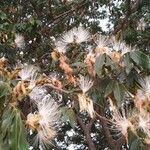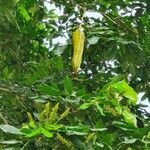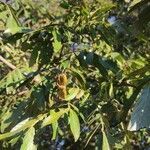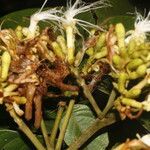Small or medium tree, the branchlets ferruginous-tomentulose, lenticellate and angled or ridged. Leaves large, usually 10-or 12-foliolate; petioles mostly 2-4 cmii. long, terete, rufous-tomentose; rachis almost 20 cm. long, tomentose like the petiole, conspicuously alate, the wing usually 5 or more mm. wide on each side of the rachis, bearing prominent, oval, cupuliform or patelliform glands be-tween insertion of the petiolules, the glands broader than long; leaflets 3-6 pairs, apparently most commonly 5 or 6 pairs in Panama, ovate to elliptic, up to 15 cm. long and 5-7 cm. wide in terminal leaflets, usually about 12 as large in basal leaflets, acute and somewhat acuminate apically, mostly rounded basally, lightly tomentose below especially on the veins, sparsely appressed-pubescent above, the veins elevated and conspicuously reticulate below, conspicuous but not elevated above; stipules caducous, reported about 5 mm. long. Inflorescence generally of a few pedunculate spikes from the leaf axils, or often paniculate by insertion of such spikes at sub-terminal defoliate nodes; spikes mostly 6-8 cm. long, floriferous for the upper 2-3 cm., the flowers moderately congested; bracts ovate, about 5 mm. long, caducous in age. Flowers white, moderate; calyx turbinate, apparently 7-8 mm long in Panama, appressed short-pilose, the teeth regular and 1-2 mm. long; corolla tubular, almost 2 cm. lcng, relatively slender and little expanded apically, densely ascending-pilose, the lobes subequal and 2-4 mm. long; stamens mostly 4 cm. (or up to 5 cm.) long, the staminal tube slightly exserted; ovary glabrous, the style slightly exceeding the stamens. Legume as much as 1 m. long and up to 2 cm. wide or wider, ferrugineous-tomentose, somewhat tetragonous or subterete, the margins almost entirely covering the faces.
More
A medium to large tree. It can be 10-20 m high. The trunk is 35-40 cm wide. The leaves are compound. They are 10-25 cm cm long. There are 4-6 pairs of leaflets. The flowers are near the ends of branches. The fruit is a long pod. It can be 1 m long and 2.5-3 cm wide. It is green. The pulp is bright white. There are several large seeds inside. The seeds are 3 cm long.
It has simply pinnate leaves with a winged rhachis, and pods with very thickened sulcate margins.
Tree to 12 m high. Flowers in spikes, white. Pod brown, c. 30-100 by 4.5 cm, with a sweet pulp.
It is a tropical plant. It can grow in the subtropics. It grows naturally in regions with an average temperature of 20°C. The rainfall is 1,000-5,000 mm per year. It grows naturally along river banks, lakes and swamps in the Brazilian Amazon. It will stand temperatures near freezing when mature. It can grow in very acid soils with a pH of 4 and with high aluminium. In Bolivia it grows up to 1500 m altitude. It suits hardiness zones 10-12.
More
Forests on the riverine flood plains. Moist, wet, or sometimes rather dry forest, or in open places at elevations below 1,500 metres. Thickets and wooded swamps at elevations of 110-540 metres in Peru.
